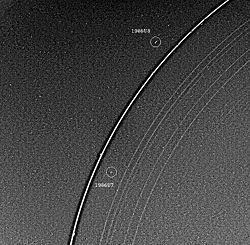Discovery date January 20, 1986 Eccentricity 0.00992 ± 0.000107 Discovered 20 January 1986 | Mean orbit radius 53,763.390 ± 0.847 km Average orbital speed 10.39 km/s Orbital period 9 hours | |
 | ||
Similar Richard J Terrile discoveries, Uranus moons, Other celestial objects | ||
Ophelia (/oʊˈfiːljə/ o-FEEL-yə) is a moon of Uranus. It was discovered from the images taken by Voyager 2 on January 20, 1986, and was given the temporary designation S/1986 U 8. It was not seen until the Hubble Space Telescope recovered it in 2003. Ophelia was named after the daughter of Polonius, Ophelia, in William Shakespeare's play Hamlet. It is also designated Uranus VII.
Other than its orbit, radius of 21 km and geometric albedo of 0.08 virtually nothing is known about it. At the Voyager 2 images Ophelia appears as an elongated object, the major axis pointing towards Uranus. The ratio of axes of the Ophelia's prolate spheroid is 0.7 ± 0.3.
Ophelia acts as the outer shepherd satellite for Uranus' Epsilon ring. The orbit of Ophelia is within the synchronous orbit radius of Uranus, and therefore the moon is slowly decaying due to tidal forces.
